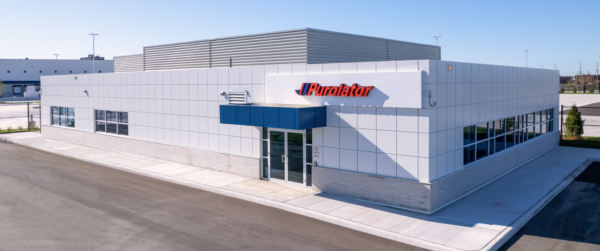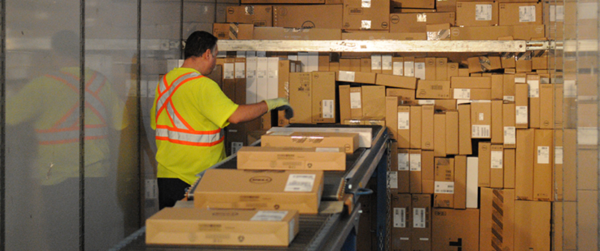The global supply chain is constantly evolving, and logistics trends for 2023 have begun to emerge. In 2021, delivery predictions in shipping and logistics saw improvements in shipping technology and the continuation of the e-commerce boom. Those supply chain trends have carried into 2023 and have further developed.
E-commerce logistics continue to rise
The e-commerce boom continues in 2023. In fact, it’s predicted to rise at a compound annual growth rate (CAGR) of 26.55% and reach $58.74 trillion USD globally by 2028. While all businesses are adapting to this trend, the logistics industry in particular is finding ways to meet the demands of online customers through new technology.
Because of the rapid rise of e-commerce, supply chain technology is racing to keep up with customer demand. Additionally, many businesses are looking for more stability this year, and are in need of flexible and resilient logistics solutions to support them—particularly in the last mile of delivery. Meanwhile, customers are looking for businesses with omnichannel shipping solutions and eco-friendly values.
Streamline your shipping and order fulfilment process with our e-commerce logistics checklist.
Customers expect personalized shipping and digital transformation in the supply chain
Personalized shipping solutions are when customers are given the option to customize and tailor their delivery to suit their needs. Usually, these features are a result of digital transformation. At its most basic, this can mean allowing customers to track their shipments or to set their preferred delivery date and time. As a result, 83% of companies are demanding that supply chains focus on improving the customer experience rather than having a traditionally product-centric approach.
Personalized shipping solutions can include:
Track packages and customize your deliveries with Purolator Your Way.
Businesses are reshoring supply chains for resilience and flexibility
As many businesses in 2023 are prioritizing stability, freight (less-than-truckload and truckload) shipping providers are looking to support them with supply chains that offer increased flexibility and efficiency, while still being resilient. This often translates to companies opting to reshore their supply chain closer to home or extend it beyond their borders. Both of these options have advantages, and how they benefit any given business depends on what they want to achieve.
Nearshoring and onshoring logistics
Both of these options provide businesses with more end-to-end control over their supply chains by having business practices located either in the same country (onshoring) or in a neighbouring country (nearshoring). Not only does this improve control, it also makes communication easier, as parties on either end of the supply chain will likely be operating in similar time zones. At the same time, these options can reduce external risks or disruptions by keeping the supply chain close-knit and more stable.
Offshoring the supply chain
When a business wants to make its supply chain as cost-effective as possible, outsourcing from another country (offshoring) has its benefits. Typically, businesses will choose to offshore their supply chain in countries where expenses are low, and the drastic difference in time zones allows operations to function around the clock. This gives their supply chains extended flexibility and agility as—depending on the time zone—they can work 24/7. While there can be challenges in Global supply chain issues, such as communication issues, reduced visibility and cross-border shipping tariffs, for many businesses that need cost-effective global logistics, the risk is well worth the reward.
Why reverse logistics and exchange processes are key for exceptional supply chain management
Customers have now come to expect returns processes to be convenient and hassle-free. This has caused new supply chain trends to emerge, forcing logistics management to evolve. Returns were once viewed as an occasional inconvenience for shoppers and a negative outcome for businesses. However, with the rise of e-commerce, returns have become an important part of the customer journey and an opportunity for businesses to improve customer loyalty and retention.
Here are a few reasons why customers are demanding simpler hassle-free returns:
Customers want convenient and package-free returns
More customers are shopping online than ever before, but nearly 30% of all e-commerce products are being returned. Because of this, companies are adapting by offering convenient returns management shipping solutions. These solutions include multiple drop-off locations, package free returns, reliable speeds (which lead to faster refunds) and digitally enabled self-serve technology available 24/7—putting control in the customer’s hands.
An efficient returns process is sustainable
Another part of why customers are interested in returns is because of their sustainability impact. Did you know that 40.5% of customers are willing to pay more for sustainable products and shipping services? And 52.5% would accept a delay of up to one week if it meant for a more sustainable delivery. Effectively recycling or reusing returned goods is a way to build loyalty and attract a growing audience of eco-friendly consumers while also streamlining your supply chain at the same time.
Enhancing your last-mile delivery solution
Recipients are looking for more convenience and control over the last-mile delivery experience. They want better tracking, sustainable deliveries and convenient return options. To overcome this supply chain challenge, shipping providers are enhancing the last mile of delivery with significant technological improvements and smart solutions. They are also looking for ways to optimize first and middle-mile logistics with automation and digital technology as well. After all, you need a streamlined process throughout your entire supply chain to perfect the last mile. Here’s how last-mile delivery logistic operations are getting an upgrade:
Dark stores are evolving
In the past few years, many small business retail owners made the decision to convert their in-person stores into micro-fulfilment centres—otherwise known as dark stores. Dark stores allow retailers to have small-scale micro-fulfilment centres that are close in proximity to their consumers, enabling faster fulfilment and delivery options like buying online and picking up in-store, curbside pick-up and home delivery.
In 2023, this trend continues to evolve as major chains have begun their own micro-fulfilment initiatives. Through “ghost kitchens” and “ghosted delivery”, customers can pick up their food or grocery orders without any dine-in or in-store shopping options. By 2033, the dark store market is predicted to be worth $414.31 billion USD, with a compound annual growth rate of 38%.
AI is taking last-mile logistics to the next level
New AI technology is making the last mile more accurate, as shipping providers are able to predict gaps or global supply chain disruptions in the process ahead of time. Here are a few examples that are taking markets by storm:
- Creating a virtual replica Companies are creating identical digital twins of their physical supply chains, so that they can run virtual simulations to see how any roadblocks will affect their logistics process. This lets them know how to react to those scenarios if they happened in reality. Additionally, it lets them optimize their physical supply chains based on any solutions or advancements made on their virtual copies. Digital modeling gives businesses the opportunity to streamline the last mile, and to find ways to improve the middle and first mile of logistics as well, giving the overall supply chain an efficiency boost.
- Using the Internet of Things (IoT) A system of objects connected over the internet allows companies to quickly transfer and collect data. The IoT lets them receive real-time and precise information on any delivery, at any time.
- Enabling machine learning These are systems that analyze huge amounts of data to determine the most optimal processes. For example, this can include identifying the most cost-effective transportation routes while also considering factors like fuel, miles and vehicle wear and tear.
- Adoption of technology integration and digital transformation Businesses are investing in technology integration to enhance supply chain planning capabilities with digital tools like AI-driven automation and predictive analytics. Digital transformation can even bring increased visibility with advanced tracking technologies, allowing supply chains to be far more flexible and agile in their response to major supply chain disruptions.
Learn how a sortation facility with cutting-edge technology is revolutionizing the supply chain.
Forecasting inventory and delivery needs
There’s no reason to run your supply chain without being aware of what’s ahead. Supply chain managers can use the latest supply chain management (SCM) technology to forecast inventory and delivery. Predicting how to deal with any roadblocks and knowing how to optimize routes is the best way to ensure profits. With SCM software, businesses can plan ahead while predicting inventory and delivery challenges, as well as be ready for any unexpected supply chain issues that come up along the way.
Customers have new expectations for logistics providers
Modern customers want their logistics providers to meet their personal needs. For example, patients want the patient-centred care offered by medical practitioners to be reflected in their delivery practices as well. Delivering patient-centred care involves the timely and personalized delivery of pharmaceuticals, surgical supplies and medical equipment. These supply chain trends are reflected in the retail sector as well, where customers want to customize their shipment from the moment it leaves the warehouse to the time it reaches their front door. Knowing how to meet evolving customer demands will be vital for any industry seeking to capitalize on this trend.
Summary of key supply chain statistics
Omnichannel shipping is bigger than ever
Creating a seamless customer experience has become the new standard for many retailers, and they can accomplish this through creating an omnichannel strategy coupled with the right delivery provider. This means regardless of where customers shop, whether online or in-store, they can have the freedom to purchase products in-store and have them delivered to their home or buy online and pick them up in-store. Ultimately, it’s about giving customers more control over the delivery process while keeping marketing consistent throughout their journey.
To meet those demands, omnichannel retailers are working with delivery providers who have flexible delivery times, online tracking and convenient returns.
Collaboration between online retailers
There’s a growing trend of collaboration between online retailers—and even between competitors. To increase their growth, retailers collaborate in fulfilment and last-mile delivery, and in supplementing their inventory and product offerings. This includes in-store pickup collaboration, sharing online shopping carts, cross-channel loyalty points and even cross-channel returns. As this trend continues, technology will need to enable retailers to manage cross-channel collaboration more conveniently.
Supply chain agility and demand forecasting
The trend in supply chain agility relates to how quickly a shipper can adjust to changes in speed and delivery. If a business has an agile supply chain, that means they can quickly react to changes, delays and roadblocks to meet customer expectations. It also relates to forecasting, which allows shippers to anticipate and bounce back from supply chain disruptions.
To support supply chain agility and forecasting, a shipper needs technology that can:
- Improve logistics operations with route optimization.
- Automate inventory management and warehousing.
- Gain visibility and access real-time data on the status of each shipment.
Sustainable green logistics is the future
Customer expectations for compostable sustainability are paving the way for companies to implement more sustainable logistics solutions. What do those solutions look like?
To reduce their carbon footprint, some shipping providers are opting for fully electric fleets to cut out carbon emissions entirely. They’re also looking at ways to install energy-efficient equipment to reduce building emissions. When switching to alternative energy sources isn’t possible, route optimization and telematics can help reduce carbon emissions.
The materials used for sustainable eco-friendly packaging are the source of nearly all solid waste in supply chain operations. Shipping providers have started optimizing packaging sizes so there aren’t excess materials, while also using recyclable, eco-friendly packaging materials like cardboard, plastic film and waste oil fluids.
Instead of a linear supply chain from manufacturer to destination, a sustainable supply chain is expected to be circular. What this means is that the reuse and recycling of products that are eco-friendly have to become an integral part of the supply chain to meet customers’ demand for convenient returns.
Producing conventional electricity is actually a major source of pollution. It’s a large source of greenhouse gasses, resulting in acid rain and polluted water bodies. That’s why sustainable logistics providers are looking to switch to green electricity, powered by green fuel and green natural gasses.
Purolator is committed to helping Canada meet net-zero emissions by 2050.
Global logistics and fulfilment
Effective supply chain management solutions allow businesses to continue their cross-border logistics and fulfilment operations despite this strategic change.
Here are a few considerations global cross-border supply chain leaders are making:
Planning for cost containment Eliminating excess costs is the key to supply chain cost containment. These extra costs are often the result of inaccurate inventory records and storage. However, monitoring this manually can take up significant time and resources. That’s why shipping providers are switching to automated solutions like connected logistics.
Areas where most businesses can optimize their costs include:
- Labour–Optimize shipment processing with AI-driven tools that can help warehouse workers pick, sort and return goods more quickly and accurately.
- Delivery and fulfilment–Connect your website or application to an order fulfilment system so that your shipping partner will receive customer orders directly, leading to a seamless logistics process.
- Inventory and storage–Track inventory with an automated system that eliminates the need for you to perform repetitive tasks, while reducing human error and offering real-time visibility.
- Shipping–Instead of spending more time and money working with multiple shipping providers, work with one shipping partner who offers you the flexibility to consolidate your courier and freight solutions into fewer shipments.
Implementing connected logistics A multi-faceted or connected logistics system helps shippers manage and lower total shipping costs. These logistics systems provide information on a shipment’s location, status and estimated time of arrival—allowing you to stay informed through the entire process. With that information, you’ll have a much easier time managing inventory costs, storage and route optimization.
Partnering with the right logistics providers An ideal shipping partner can benefit any company; however, they are especially effective when a business needs to reduce costs on cross-border shipping. Many shipping providers already use connected logistics and other automated solutions, so you know your shipment is in good hands. They’ll also manage warehouse storage, inventory, returns, exchanges and retail distribution. Additionally, the right partner will be able to effectively clear shipments into foreign markets with customs brokerage, ensuring a smooth cross-border journey.
Data security and privacy in the supply chain
As digital transformation is becoming more deeply ingrained in supply chain and logistics systems, data privacy regulations are becoming increasingly important. It’s now vital for logistics businesses to keep their customers’ data safe while also meeting their expectations.
A few data privacy security measures include:
- Establishing a data protection plan—This outlines how you will obtain consent from customers before collecting, using and storing their data.
- Training your employees—All employees should be aware of your data privacy regulations and how to comply with them.
- Stay up to date with new regulations—Regularly review your data collection practices and keep up with the latest changes to ensure you’re using the best security methods to keep customer data safe.
Improvements in supply chain visibility
Businesses have the capability to share more information with their customers and stakeholders than ever before. And technological advances have raised the bar for transparency, with social media playing a major role in how companies communicate with consumers today. Here are three ways shipping companies are using new technology to get a deeper understanding of their own systems, while also giving customers a clearer picture.
- Traceability: Supply chain traceability is all about tracking the journey of products from end to end. Traceability provides opportunities to improve the supply chain journey by honing in on the exact areas that need to be streamlined. It also allows the shipper to connect with recipients through QR codes or pictures, giving customers a clearer understanding of how their shipment reached them and where it’s located.
- Mapping: This is the process of creating an outline of all the companies and stakeholders involved within a supply chain. By mapping out the supply chain, it becomes easier to find the strengths and weaknesses at each stage, and where it needs support. For example, mapping can pinpoint that delays in the supply chain are caused by challenges further upstream in the collection of raw goods—such as mining or farming. By identifying the issue, it becomes a lot easier to solve.
- Transparency: While supply chain transparency is often about giving customers complete visibility into the shipping journey, that’s really just one side of it. Transparency also includes choosing to reveal information in a way that’s strategic. For example, another form of transparency can be revealing that your packaging is using sustainable materials to engage an eco-friendly audience. It’s all about communicating with customers and stakeholders to give them detailed insight into your supply chain, while also raising their awareness and interest in your services.
Looking for more details on 2023’s global supply chain trends? Check out our whitepaper.
What’s next for global logistics and supply chain strategies?
In 2023, the global supply chain continues to adapt to the e-commerce boom. Customers are demanding omnichannel retail experiences, convenient e-commerce returns and sustainable logistics shipping solutions. It’s likely that these supply chain trends will remain prevalent throughout the year as businesses hold their growth and adopt flexible strategies to overcome logistical challenges. And while we can’t guarantee what will happen in the future, knowing what the current and emerging trends in supply chain management are will better equip your business to find new opportunities down the line.







